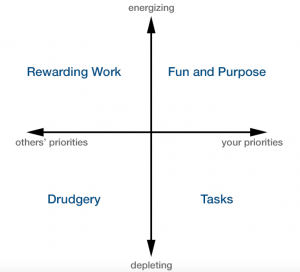
In a digital world, where everything is connected from credit card purchases, to social media posts, to even traffic jams; we still crave for deep connections. A deep feeling of engagement persists when you get alone time from your energetic kids to have an adult dinner (uninterrupted), or simply take a walk along the lakeside. Balancing it all just seems impossible and imperfect. Instead of getting caught up on all the items to organize in your so-called “work-life balance”, a better approach is simply to have less items to organize.
It’s quiet fine to say no. Frankly, you can’t do everything, for everyone, all the time.
Research from University of California proves the more trouble you have saying no, the more likely you experience burnout. It comes straight down to workload, and you are single resource. You can argue it’s for volunteering, for the community, for climbing the corporate ladder; yet in the end letting go of perfectionism, delegating tasks, and simply saying no will be better for your health, your mind, and your family.
Getting to that mental state of “saying no” comes about by switching your mental gears on and recognizing your patterns. Catch yourself…how quickly do you often say yes? How frequently in one hour, one day, one week, do you agree to something that was not originally on your to-do list? By you doing things for others, doesn’t really give them the opportunity to try, to explore, to simply learn for themselves. And that is part of your job – letting it go.
Often we lack the deep feeling of engagement, that mental state that many label as “flow”, says Mihaly Csikszentmihalyi, Hungarian-American psychologist. As a distinguished professor at Claremont University-CA, he is famous for documenting the concept of “flow”, “getting in the zone” that many athletes report on achieving, as well as autoletic activities, whereby an individual is internally driven which allows them to be productive with a sense of purpose. His work is quite incredible when applied to everyday activities.
 Instead of a to-do list, plot out your items along two axis lines. The first being horizontal axis where the left are other people’s priorities, and the right being your priorities. The vertical axis top being fun/energizing and the bottom being drudgery/depleting. If you plot your activities that fill up your day along those two lines, then you will uncover where you are spending most of your energy. Is it for others or for yourself? Does that activity align with your internal goals or family values? What reward exists for you to repeat this pattern, if any?
Instead of a to-do list, plot out your items along two axis lines. The first being horizontal axis where the left are other people’s priorities, and the right being your priorities. The vertical axis top being fun/energizing and the bottom being drudgery/depleting. If you plot your activities that fill up your day along those two lines, then you will uncover where you are spending most of your energy. Is it for others or for yourself? Does that activity align with your internal goals or family values? What reward exists for you to repeat this pattern, if any?
Keep in mind there certainly are some things that you might dread doing such as going to the dentist, but those are appointments that are good for your health. Or perhaps it’s public speaking; yet that is an opportunity for personal growth. The point here is to work with the items, plot them, and over time have less of them in your life for more balance and less exhaustion. The stakes are high because you are shifting them to your life, in your favor, and that is where productivity starts.
Sources:
1-https://hbr.org/2019/07/6-causes-of-burnout-and-how-to-avoid-them
2-The Balanced Matrix: Lauren Bacon, Jan 2014.
Don’t have PayPal? You can simply choose to use any one of your other credit or debit cards at the point of the PayPal checkout.